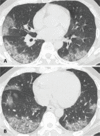Imaging findings in COVID-19 pneumonia
- PMID: 32578826
- PMCID: PMC7297525
- DOI: 10.6061/clinics/2020/e2027
Imaging findings in COVID-19 pneumonia
Abstract
The coronavirus disease (COVID-19), caused by the severe acute respiratory syndrome coronavirus 2 (SARS-CoV-2), emerged in Wuhan city and was declared a pandemic in March 2020. Although the virus is not restricted to the lung parenchyma, the use of chest imaging in COVID-19 can be especially useful for patients with moderate to severe symptoms or comorbidities. This article aimed to demonstrate the chest imaging findings of COVID-19 on different modalities: chest radiography, computed tomography, and ultrasonography. In addition, it intended to review recommendations on imaging assessment of COVID-19 and to discuss the use of a structured chest computed tomography report. Chest radiography, despite being a low-cost and easily available method, has low sensitivity for screening patients. It can be useful in monitoring hospitalized patients, especially for the evaluation of complications such as pneumothorax and pleural effusion. Chest computed tomography, despite being highly sensitive, has a low specificity, and hence cannot replace the reference diagnostic test (reverse transcription polymerase chain reaction). To facilitate the confection and reduce the variability of radiological reports, some standardizations with structured reports have been proposed. Among the available classifications, it is possible to divide the radiological findings into typical, indeterminate, atypical, and negative findings. The structured report can also contain an estimate of the extent of lung involvement (e.g., more or less than 50% of the lung parenchyma). Pulmonary ultrasonography can also be an auxiliary method, especially for monitoring hospitalized patients in intensive care units, where transfer to a tomography scanner is difficult.
Conflict of interest statement
No potential conflict of interest was reported.
Figures













References
-
- WHO Director-General's opening remarks at the media briefing on COVID-19 . 2020. Available from: https://www.who.int/dg/speeches/detail/who-director-general-s-opening-re... [cited Mar 23th, 2020]
-
- Recomendações de uso de métodos de imagem para pacientes suspeitos de infecção pelo COVID-19 . 2020. Available from: https://cbr.org.br/wp-content/uploads/2020/04/Recomenda%C3%A7%C3%B5es-de... [cited Apr 20th, 2020]
Publication types
MeSH terms
LinkOut - more resources
Full Text Sources
Miscellaneous

